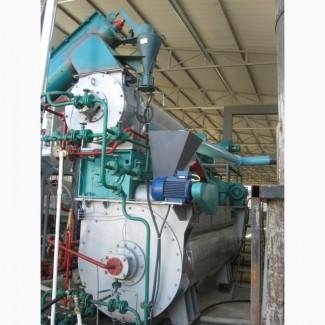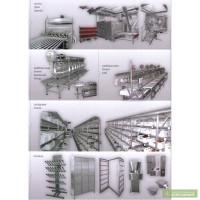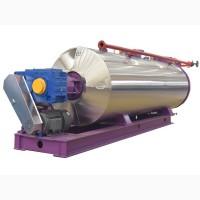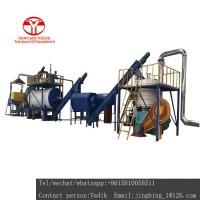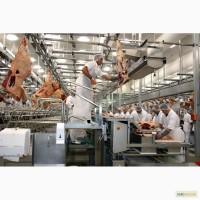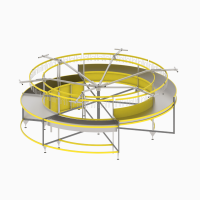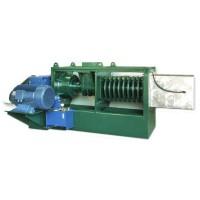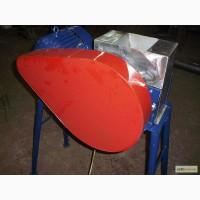/ Agricultural equipment, equipment, inventory / Food industry (equipment) /Meat equipment / Various meat equipment + in assortment / Installation for the processing of meat and bone waste ...
For sale / buy
A plant for the processing of meat and bone waste with a capacity of up to 5 tons, Lviv region.
Price|| |13510 UAH.
Region:all of Ukraine,
Lviv region.
(Львов)
Updated:
Device and principle of operation of a flour and flour plant
Before feeding the meat and bone raw material to the cooker, it is preliminarily ground in two stages: grinding to a fraction of 13 mm along the bone, then grinding to 1-3 mm in the pasta maker. The prepared raw material is fed into the storage hopper. From the hopper, it is fed to the digester by a screw dispenser. Boiled mass from the cooker enters the screw press.
In the press, a broth with fat is squeezed out of the boiled mass, which is pumped into a septic tank by a pumping unit. Pressed pulp enters the dryer. The pulp is dried, slowly moving along the dryer in the form of coarse flour (dried). From the dryer, coarse flour, mixed with an antioxidant, is sucked into the mill unit through a magnetic barrier, where it is crushed and sent to the cyclone through the air ducts of the pneumatic transport, from where it is sent to the packaging through the sluice gate and the unloading unit. Moisture evaporated during the drying process is removed by air passing through the dryer, which, passing through the dryer, is cleaned of suspended flour particles and thrown into the atmosphere.
The broth in the septic tank, which has two compartments, is separated by density: sludge in the lower part, clarified broth in the middle, and fat in the upper part. With the help of apump, the slurry is fed into the dryer. The fat is sent to the storage tank by gravity. The clarified broth is sent to the collector or sewer.
The stage of acceptance and grinding of meat and bone waste (MKO)
Shredder
Shredding of military and meat-and-bone waste without prior cutting. The dimensions of the loading hatch are 50x60 cm. Universal equipment capable of simultaneously grinding large bones (including heads of cattle with horns, hooves, joints) and soft waste (guts with cowhide, etc.). The shredder offered here is one of the most simple and reliable (powerful, scary and nuclear)) ) ) . There is no lower performance of such machines, and those that are, will constantly break and choke on bones, or require constant replacement or sharpening of knives. I recommend this shredder, because other machines of a similar type do not give such a fine fraction at the output, or have a small opening for loading (and this requires additional preliminary chopping or cooking in autoclaves).
Productivity 2 t / hour.
Email two 30 kW
Dimensions LxWxH 2.28x1.1x2.32 m
Mass 2.32 t
Reception table
Acceptance of meat and bone waste is carried out from special containers to the receiving table. The receiving table above the shredder is a welded and rather simple structure, from which bones and military waste are dumped into the hatch of the shredder with a scraper. Any welder can make a platform with a ladder and a fence on the spot, so there is no detailed description here; upon request, we will provide a diagram.
With small volumes of incoming raw material, it is easier to load it manually.
A tipper lift with a loading height of up to 2.2 m.
An elevator with a loading height of up to 2.2 m and a box weight of 200-350 kg lifts the incoming raw material to the receiving table, from which the raw material is loaded into the receiving hatch of the crusher. It is desirable to place the crusher closer to the gate of the workshop, where the waste will be transported.
Screw conveyor for a pasta maker with a feed height of 1.4 m.
It is equipped with a receiving bunker and a BU. The maximum angle of inclination is 45 degrees. The maximum productivity is up to 25 t/h for dry grain.
Length 4m, diameter 0.2m. Screw speed 80 rpm. Power 2.2 kW. On request, it can be equipped with a frequency converter for speed regulation.
Pasta maker for fractions no larger than 1-3 mm.
Necessary for bringing crushed bone waste to the condition (for cooking) size.
Productivity up to 6 t / hour
Email two 30 kW
Dimensions LxWxH 1.1x0.75x1.35 m
Mass 0.5 t
Screw conveyor from the pasta maker to the storage hopper
with a feed height of 2.5 m. Length 4.6 m, diameter 0.2 m, feed height 2 m.
* All screw conveyors are equipped with a flushing system.
** The thickness of the housing wall is not less than 2.2 mm.
Flour plant
In order to place the installation at enterprises, you need to have:
1. Istochnica vodosnabzheniya
2. Treatment facilities or sewage treatment plants
3. Power source 380 V, 50 Hz
4. Premises with an area of at least 40 m2 and a height of at least 3.5-4 m.
5. Boiler room or steam generator with output parameters up to: steam 120 kg/hour, pressure 5 atm.
The installation is operated by one person, since all control functions are combined in one control panel, plus an auxiliary worker for loading incoming waste.
(//tractor-service.com)
Technical characteristics of the fat flour plant:
Raw material productivity, t/day………….……………………………….... 2-5
Steam working pressure, MPa……………………………………………….………..……….0.5
Steam consumption, kg / h, no more………………………………………………………………..…... 120
The amount of condensate returned to the boiler, kg / time, not less....…...….116
Water consumption, m3 / h, no more (with recirculation) …………………………....…….0.5
Installed power of electric motors, kW, no more than………………...…….20
The temperature of the flour supplied for packaging, oC, not more than 30
Overall dimensions, mm, no more: ………………….. …7500 x 3200 x 2220 (height)
Mass, kg, no more…………………………………………………………………………..6000
The installation consists of the following blocks:
1. Heat treatment unit
2. Block of transportation and packaging
3. Tank sludge
4. Control panel
5. Conveyor for supplying crushed raw materials
6. Cabinet with frequency converters
After installation, the flour plant is a monobloc, compact unitary equipment,
* Separator for separating fat is excluded. The centrifuge for clarifying the broth is excluded. This is due to the fact that the processing of liquid fractions obtained as a result of boiling, and the further sale of the resulting fat in chemical and perfume industries, with low productivity, as a rule, does not have economic benefits with considerable investments in broth separation equipment.
In any case, we can offer this additional set of equipment upon request. As a rule, the separation of the broth is associated with difficulties with the direct discharge of the primary broth into the sewer.
In time, at this productivity, about 50-200 liters of broth can be obtained, depending on the moisture level of the incoming raw material (fat output from the broth in % is determined experimentally). The clarified broth is collected in a storage tank (with a pump or a self-contained unit - it is decided when designing the workshop), then either on the irrigation fields (the best option in terms of simplicity and efficiency) or as an additive to cattle feed. If you just pour it into the sewer, then over time there will definitely be blockages and possible problems with the SES. Therefore, with a direct drain, there is a need to install a sewage grease trap. As a rule, such equipment is inexpensive and compact.
The steam generator (in the absence of a boiler room) is a monobloc design: a thermally insulated steam generating boiler, a waterpump vortex type, a power supply unit and an automatic control unit are located in a closed housing. The electrode principle of steam generation provides high quality steam and efficiency, gives the opportunity to obtain steam after 5-10 minutes after the start of work. Undemanding to the quality of drinking water.
Steam productivity when 6 electrodes are turned on, kg / h 100
Boiler volume of the steam generator, l 25
Steam pressure at the outlet, kgf/sq. cm 1-5.5
Steam temperature, °С 120-160
Installed power, no more, kW 80
Overall dimensions, mm 700x700x800
Mass, kg 110
The final stage
* Since the productivity of this installation is small, the finished product can be packed in paper bags manually.
Weighing dispenser, on a trestle (steel profile frame).
The bag is hung on the rack, clamped with a mechanical (or pneumatic) bag clamp, and dosing is turned on. After forming the dose, the operator replaces the bag.
Dosing limits 1-50 kg (hopper 400 l)
Productivity up to 180 doses / time
Dose accuracy 2%
Power 1 kW
Voltage 220 V
The height of the sewn sack is 0.6-1.1 m.
Dimensions 1.2m x 1.2m x 2.5m
Mass no more than 230 kg.
Air consumption 50 l / min (Р=0.6-0.8 MPa)
* Add. equipment:
- Bucket conveyor
- Floor hopper-feeder (volume 250 l)
Before feeding the meat and bone raw material to the cooker, it is preliminarily ground in two stages: grinding to a fraction of 13 mm along the bone, then grinding to 1-3 mm in the pasta maker. The prepared raw material is fed into the storage hopper. From the hopper, it is fed to the digester by a screw dispenser. Boiled mass from the cooker enters the screw press.
In the press, a broth with fat is squeezed out of the boiled mass, which is pumped into a septic tank by a pumping unit. Pressed pulp enters the dryer. The pulp is dried, slowly moving along the dryer in the form of coarse flour (dried). From the dryer, coarse flour, mixed with an antioxidant, is sucked into the mill unit through a magnetic barrier, where it is crushed and sent to the cyclone through the air ducts of the pneumatic transport, from where it is sent to the packaging through the sluice gate and the unloading unit. Moisture evaporated during the drying process is removed by air passing through the dryer, which, passing through the dryer, is cleaned of suspended flour particles and thrown into the atmosphere.
The broth in the septic tank, which has two compartments, is separated by density: sludge in the lower part, clarified broth in the middle, and fat in the upper part. With the help of apump, the slurry is fed into the dryer. The fat is sent to the storage tank by gravity. The clarified broth is sent to the collector or sewer.
The stage of acceptance and grinding of meat and bone waste (MKO)
Shredder
Shredding of military and meat-and-bone waste without prior cutting. The dimensions of the loading hatch are 50x60 cm. Universal equipment capable of simultaneously grinding large bones (including heads of cattle with horns, hooves, joints) and soft waste (guts with cowhide, etc.). The shredder offered here is one of the most simple and reliable (powerful, scary and nuclear)) ) ) . There is no lower performance of such machines, and those that are, will constantly break and choke on bones, or require constant replacement or sharpening of knives. I recommend this shredder, because other machines of a similar type do not give such a fine fraction at the output, or have a small opening for loading (and this requires additional preliminary chopping or cooking in autoclaves).
Productivity 2 t / hour.
Email two 30 kW
Dimensions LxWxH 2.28x1.1x2.32 m
Mass 2.32 t
Reception table
Acceptance of meat and bone waste is carried out from special containers to the receiving table. The receiving table above the shredder is a welded and rather simple structure, from which bones and military waste are dumped into the hatch of the shredder with a scraper. Any welder can make a platform with a ladder and a fence on the spot, so there is no detailed description here; upon request, we will provide a diagram.
With small volumes of incoming raw material, it is easier to load it manually.
A tipper lift with a loading height of up to 2.2 m.
An elevator with a loading height of up to 2.2 m and a box weight of 200-350 kg lifts the incoming raw material to the receiving table, from which the raw material is loaded into the receiving hatch of the crusher. It is desirable to place the crusher closer to the gate of the workshop, where the waste will be transported.
Screw conveyor for a pasta maker with a feed height of 1.4 m.
It is equipped with a receiving bunker and a BU. The maximum angle of inclination is 45 degrees. The maximum productivity is up to 25 t/h for dry grain.
Length 4m, diameter 0.2m. Screw speed 80 rpm. Power 2.2 kW. On request, it can be equipped with a frequency converter for speed regulation.
Pasta maker for fractions no larger than 1-3 mm.
Necessary for bringing crushed bone waste to the condition (for cooking) size.
Productivity up to 6 t / hour
Email two 30 kW
Dimensions LxWxH 1.1x0.75x1.35 m
Mass 0.5 t
Screw conveyor from the pasta maker to the storage hopper
with a feed height of 2.5 m. Length 4.6 m, diameter 0.2 m, feed height 2 m.
* All screw conveyors are equipped with a flushing system.
** The thickness of the housing wall is not less than 2.2 mm.
Flour plant
In order to place the installation at enterprises, you need to have:
1. Istochnica vodosnabzheniya
2. Treatment facilities or sewage treatment plants
3. Power source 380 V, 50 Hz
4. Premises with an area of at least 40 m2 and a height of at least 3.5-4 m.
5. Boiler room or steam generator with output parameters up to: steam 120 kg/hour, pressure 5 atm.
The installation is operated by one person, since all control functions are combined in one control panel, plus an auxiliary worker for loading incoming waste.
(//tractor-service.com)
Technical characteristics of the fat flour plant:
Raw material productivity, t/day………….……………………………….... 2-5
Steam working pressure, MPa……………………………………………….………..……….0.5
Steam consumption, kg / h, no more………………………………………………………………..…... 120
The amount of condensate returned to the boiler, kg / time, not less....…...….116
Water consumption, m3 / h, no more (with recirculation) …………………………....…….0.5
Installed power of electric motors, kW, no more than………………...…….20
The temperature of the flour supplied for packaging, oC, not more than 30
Overall dimensions, mm, no more: ………………….. …7500 x 3200 x 2220 (height)
Mass, kg, no more…………………………………………………………………………..6000
The installation consists of the following blocks:
1. Heat treatment unit
2. Block of transportation and packaging
3. Tank sludge
4. Control panel
5. Conveyor for supplying crushed raw materials
6. Cabinet with frequency converters
After installation, the flour plant is a monobloc, compact unitary equipment,
* Separator for separating fat is excluded. The centrifuge for clarifying the broth is excluded. This is due to the fact that the processing of liquid fractions obtained as a result of boiling, and the further sale of the resulting fat in chemical and perfume industries, with low productivity, as a rule, does not have economic benefits with considerable investments in broth separation equipment.
In any case, we can offer this additional set of equipment upon request. As a rule, the separation of the broth is associated with difficulties with the direct discharge of the primary broth into the sewer.
In time, at this productivity, about 50-200 liters of broth can be obtained, depending on the moisture level of the incoming raw material (fat output from the broth in % is determined experimentally). The clarified broth is collected in a storage tank (with a pump or a self-contained unit - it is decided when designing the workshop), then either on the irrigation fields (the best option in terms of simplicity and efficiency) or as an additive to cattle feed. If you just pour it into the sewer, then over time there will definitely be blockages and possible problems with the SES. Therefore, with a direct drain, there is a need to install a sewage grease trap. As a rule, such equipment is inexpensive and compact.
The steam generator (in the absence of a boiler room) is a monobloc design: a thermally insulated steam generating boiler, a waterpump vortex type, a power supply unit and an automatic control unit are located in a closed housing. The electrode principle of steam generation provides high quality steam and efficiency, gives the opportunity to obtain steam after 5-10 minutes after the start of work. Undemanding to the quality of drinking water.
Steam productivity when 6 electrodes are turned on, kg / h 100
Boiler volume of the steam generator, l 25
Steam pressure at the outlet, kgf/sq. cm 1-5.5
Steam temperature, °С 120-160
Installed power, no more, kW 80
Overall dimensions, mm 700x700x800
Mass, kg 110
The final stage
* Since the productivity of this installation is small, the finished product can be packed in paper bags manually.
Weighing dispenser, on a trestle (steel profile frame).
The bag is hung on the rack, clamped with a mechanical (or pneumatic) bag clamp, and dosing is turned on. After forming the dose, the operator replaces the bag.
Dosing limits 1-50 kg (hopper 400 l)
Productivity up to 180 doses / time
Dose accuracy 2%
Power 1 kW
Voltage 220 V
The height of the sewn sack is 0.6-1.1 m.
Dimensions 1.2m x 1.2m x 2.5m
Mass no more than 230 kg.
Air consumption 50 l / min (Р=0.6-0.8 MPa)
* Add. equipment:
- Bucket conveyor
- Floor hopper-feeder (volume 250 l)
|
Author, contacts | |
Velmark M / отзывы, инфо. / activity evaluation | |
|
Phone:
+38(xxxxxx
show || |290
| |
| Skype: vlad013 | |
| http://www.wellmarkm.net | |
| facebook.com/wellmarkm | |
All user ads ~87 | |
Ad ID: #1000357
(added by a registered user, registration date: 21-07-2013)
Added/Updated: 17 -09-2024 15:05 (relevant, until: 09-17-2025)
Permanent ad address:
Showed / watched for today: ?, total: ?
Similar ads
Among them there are many interesting...
Вся Украина: Food industry (equipment) 1516 / Meat equipment 256 / Raznoe meat equipment + in assortment 50
Lviv region: Food industry (equipment) 125 / Meat equipment 50 / Raznoe meat equipment + in assortment 26
